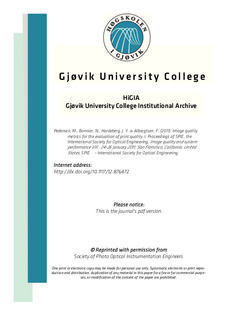| dc.contributor.author | Pedersen, Marius | |
| dc.contributor.author | Bonnier, Nicolas | |
| dc.contributor.author | Hardeberg, Jon Yngve | |
| dc.contributor.author | Albregtsen, Fritz | |
| dc.date.accessioned | 2011-04-18T08:03:40Z | |
| dc.date.available | 2011-04-18T08:03:40Z | |
| dc.date.issued | 2011 | |
| dc.identifier.citation | Pedersen, M., Bonnier, N., Hardeberg, J. Y. & Albregtsen, F. (2011). Image quality metrics for the evaluation of print quality. I: Proceedings of SPIE, the International Society for Optical Engineering, Image quality and system performance VIII : 24-26 January 2011, San Francisco, California, United States, SPIE - International Society for Optical Engineering. | en_US |
| dc.identifier.isbn | 9780819484048 | en_US |
| dc.identifier.issn | 0277-786X | |
| dc.identifier.uri | http://hdl.handle.net/11250/142566 | |
| dc.description | This is the copy of journal's version originally published in Proc. SPIE 7867: http://spie.org/x10.xml?WT.svl=tn7. Reprinted with permission of SPIE. | en_US |
| dc.description.abstract | Image quality metrics have become more and more popular in the image processing community. However, so far, no one has been able to define an image quality metric well correlated with the percept for overall image quality. One of the causes is that image quality is multi-dimensional and complex. One approach to bridge the gap between perceived and calculated image quality is to reduce the complexity of image quality, by breaking the overall quality into a set of quality attributes. In our research we have presented a set of quality attributes built on existing attributes from the literature. The six proposed quality attributes are: sharpness, color, lightness, artifacts, contrast, and physical. This set keeps the dimensionality to a minimum. An experiment validated the quality attributes as suitable for image quality evaluation. The process of applying image quality metrics to printed images is not straightforward, because image quality metrics require a digital input. A framework has been developed for this process, which includes scanning the print to get a digital copy, image registration, and the application of image quality metrics. With quality attributes for the evaluation of image quality and a framework for applying image quality metrics, a selection of suitable image quality metrics for the different quality attributes has been carried out. Each of the quality attributes has been investigated, and an experimental analysis carried out to find the most suitable image quality metrics for the given quality attributes. For the sharpness attributes the Structural SIMilarity index (SSIM) by Wang et al. (2004) is the the most suitable, and for the other attributes further evaluation is required. | en_US |
| dc.language.iso | eng | en_US |
| dc.publisher | Society of Photo Optical Instrumentation Engineers (SPIE) | en_US |
| dc.relation.ispartofseries | Proceedings of SPIE;7867 | |
| dc.title | Image quality metrics for the evaluation of print quality | en_US |
| dc.type | Journal article | en_US |
| dc.type | Peer reviewed | en_US |
| dc.subject.nsi | VDP::Mathematics and natural science: 400::Information and communication science: 420::Simulation, visualization, signal processing, image processing: 429 | en_US |
| dc.source.pagenumber | 19 | en_US |
| dc.identifier.doi | 10.1117/12.876472 | |
